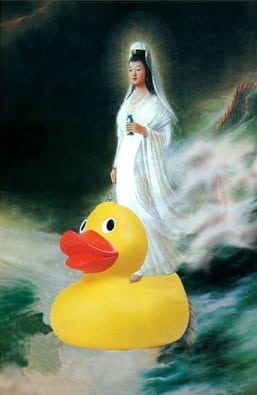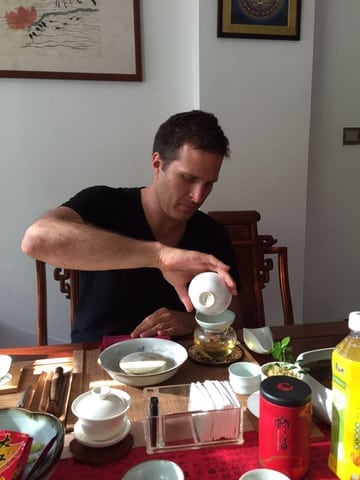Perhaps it is because I have a near-glandular reaction to all things shiny, or perhaps it’s something more visceral. Whatever the case may be, I love teas with the world “Gold” in them. It wasn’t something I was particular aiming for, but more of an epiphany I had over one particular type of tea.

I received a sample of Zen Tara Tea’s Golden Yunnan Special. Looking at it was like beholding beige-like brilliance…and like honey-lathered lightning had hit my tongue. At first, I thought it was possibly a fluke, but then I visited a teashop local to me – the Jasmine Pearl – and picked up some of their Golden Needles. The reaction was just about the same – honey-pepper-nectar-gasm. From that point on, I had a favorite black tea.
Naturally, I wondered if other teas with the word “Gold” were equally as perfect for my palate. The next on the list was the Fujian-grown Golden Monkey – often heralded as the black tea equivalent to Bai Hao Yinzhen (Silver Needle), a distinction I’d disagree with. While having a similar gold-like, tippy presence as the Yunnan variety, the leaves were smaller and curlier. However, they did impart a similar nectar-like flavor, if not as eye-glazing. Okay, second time was the charm; this was definitely not a fluke. Maybe it was an irregularity.
On a random perusal, I ran across a product dubbed a “Golden Assam”. Perhaps it was a Photoshop trick, but the merchandise photo made it look just as shiny as a Yunnan Gold (or Jin Cha). A fellow tea colleague – Michael J. Coffey, ever the steep scientist – urged me to reel in my expectations. According to one of his Assamese contacts (yes, the man has contacts), gold tips are often added for visual flare but have no effect on taste. Much like cornflowers being added to some inferior Earl Greys.
A random tea outing with a gold-haired friend confirmed my “findings”. Their gold-tipped Assam did indeed have some honey texture to go along with the requisite malt. I even ordered another pot of Yunnan Gold just for taste comparison. While the latter was better, the Assam did hold its own.

Some doubts did enter my mind about the “gold standard” when I revisited gold-tipped Assams in the form of a Khongea estate offering. It was really good – malty, hearty, slightly smoky, all those manly adjectives. But it didn’t possess that ‘gasmic “oomph” of the prior golds. Maybe Coffey had a point.
The conversation was revisited, this time with Assam-lover, Ken Macbeth, in tow. It even inspired this write-up from Ken regarding the price one pays for the appearance of a loose leaf batch. MJC even reiterated that while there is likely a flavor I’m subjective to in Yunnan Golds – or to the “golding” process in general – that doesn’t make it universally better. At the time of the conversation, I refused to believe it.
Then I taste-tested two teas from Canton Tea Co. One was a black tea from Fujian (my favorite Chinese province) called Bai Lin Gong Fu. It looked and smelled like a black tea – like a Dian Hong (regular Yunnan black) only tippier. The taste, though…wow. It made me tip my head back in Homer-esque reverie, tongue splayed.
A few months later, I received another sample from Canton for their Superior Bai Lin Gong Fu. I wondered how the heck they could top the regular kind, but – apparently – what made it superior was the appearance. The entire batch was GOOOOooooooOOOOoooold! However…I noted in my review of it, that – while I did love it – I preferred the regular Bai Lin. The honey-nectar presence was there, but it simply didn’t top the silky magnificence of its darker kin.

Superior vs. Inferior (?)
My journey came practically full circle with a revisit to The Jasmine Pearl. The owners – Chuck and Heather – were a very patient couple in dealing with me. They had mentioned in passing that a new shipment was coming in for some Golden Needles, straight from Yunnan, and that it was even better than their last one. Perfect timing since I ran out of my stores of their last batch. They urged me to be patient, though. Deliveries from China were known to be slow.
That didn’t stop me from calling them repeatedly.
Me: “Is it there yet?”
Them: “No.”
Geoff: “How ‘bout now?”
Them: “No.”
Me: [pause] “Now?”
Them: “No.”
Me: “Are we there yet?”
Them: “What?”
Me: “What?”
(Okay, I made that last part up.)
A month ago, I stopped in to childishly ask one more time. Rays of heaven parted when they confirmed with an emphatic “Yes!” that it, indeed, had arrived. There was a problem, though. This was nowhere near as gold-tippy as the last batch. It smelled wonderful – like tiramisu, chocolate, and forest – but the peppery aspect was all but gone. I bought it anyway and did a side-by-side comparison with another Golden Needle I had on hand.

Gold vs. (Mostly) Gold
Yep, definitely darker.
Then came the taste-test.
Oh wow.
Oh my…wow…
Oh wowie-wowie-wow-wow.
I rated the last Golden Needles they had a ten out of ten. This was an eleven. It was then that I begrudgingly admitted that there was something to the processing. Here it was, a darker Golden Yunnan, and I liked it better than any of its shinier kin. Fine, I’ll admit it now. The “golding” process doesn’t necessary make it better, but there is still something to it in terms of Chinese black teas. I’m standing by my Yunnan Goldies, even the ones that are rougher around the edges.









